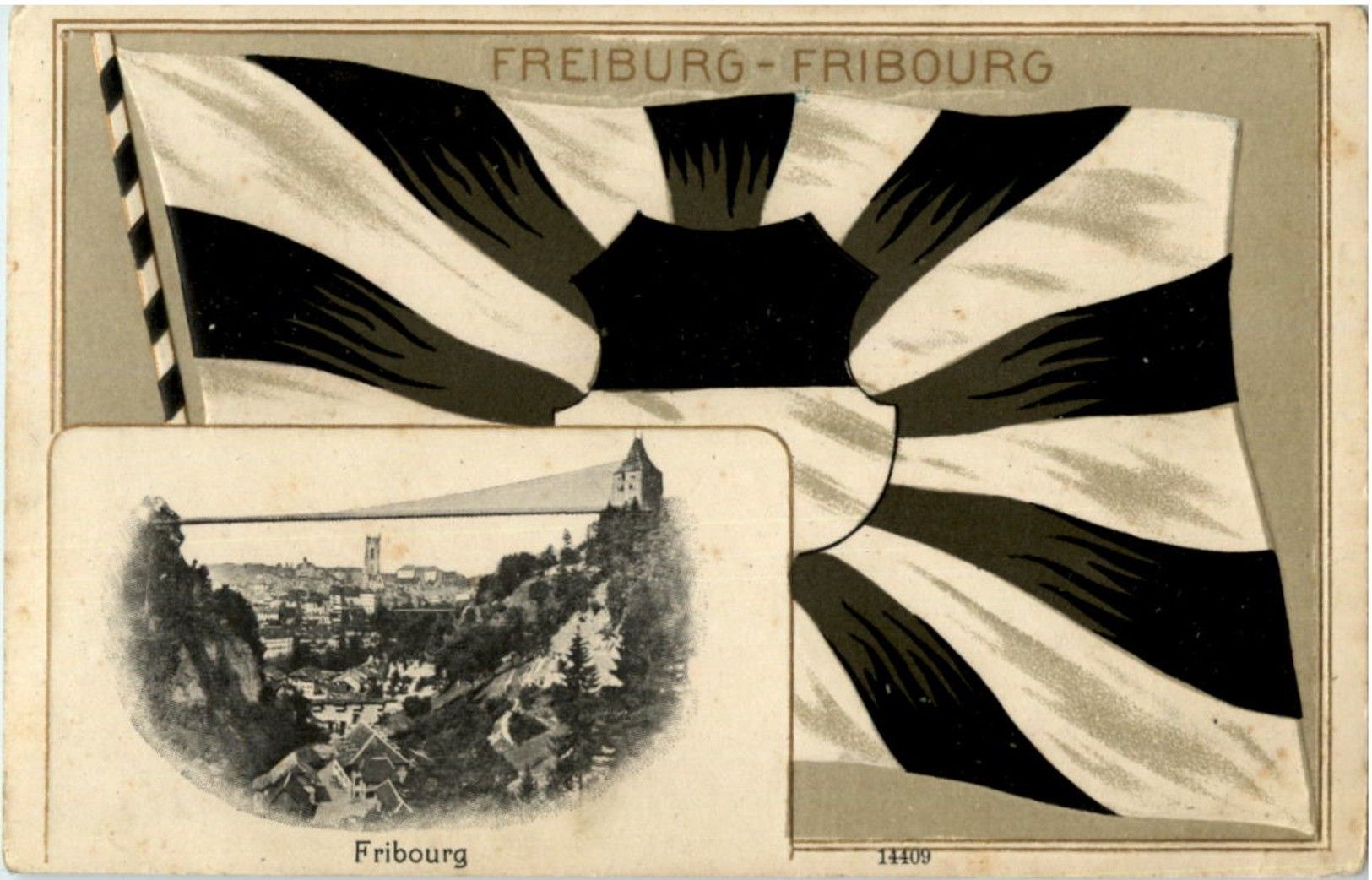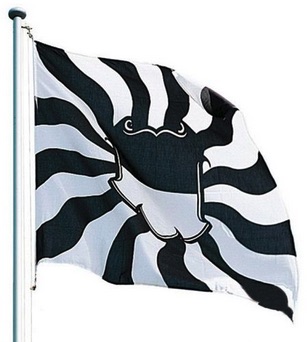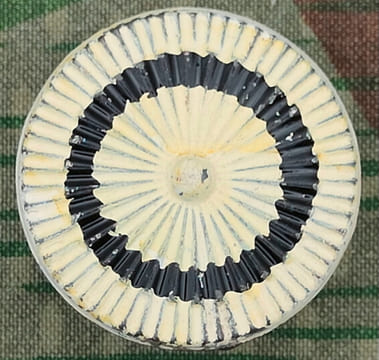Flaggen, Knatterfahnen and Livery Colours
![[Knatterfahnen]](../images/c/ch-fr_kf.gif)

Last modified: 2025-03-29 by martin karner
Keywords: switzerland | freiburg | fribourg | french | german |
Links: FOTW homepage |
search |
disclaimer and copyright |
write us |
mirrors
![[Flag of Fribourg/Freiburg]](../images/c/ch-fr.gif) image by António Martins
image by António Martins
Description of the Flag
Per fess sable and argent.
Divided horizontally into equal parts black over white.
T.F. Mills, 19 October 1997
Symbolism of the Flag
There is no definite understanding of the symbolism of Fribourg's
flag, but there are several theories. One, and certainly the most interesting
legend, has it that Duke Berchtold IV of Zahringia (Zähringen), founder of the city, spent a night in a
charcoal burner's hut after being separated from his hunting party.
He slept on sacks of charcoal and flour, and emerged in the morning
all soiled black and white. He was thus inspired to grant his new
town a black and white flag. Another
claims that the black represents the rich cultivated earth, while
the white is the water surrounding the city (Sarine River). A third holds that
black represents the clergy which was dominant there, as in their black
vestments, representing piety, devotion, and self-denial.
T.F. Mills, 19 October 1997
The legend about the duke sleeping on bags of charcoal and flour is by
far the most commonly advanced explanation, although it is most likely of
mythological origin. The theory that it represents vestments of the clergy is
the least probable since the domination of Catholic clergy has only started much
later than the adoption of the flag by the city itself. It is a classic
historical post-dating operation from the Kulturkampf-era when anti-Catholic
sentiment was fierce in Switzerland's mainstream culture. The second hypothesis
is the most colloquial, if you will. In other words: it may mean much or nothing
at all – I have neither seen a reliable source for the first nor for the this
suggestion. The "charcoal and flour" legend is however widely proposed by the
historical literature as an anecdotal explanation for the Fribourg/Freiburg
flag.
Bernhard Altermatt, 13 February 2008
History of the Flag
The city of Fribourg was founded in 1157. The battle flag may have
been adopted as early as 1225, but the earliest documented evidence
of it is in 1410 (Since the city-state was waging war in the early
13th century, it had to have a war flag). Until 1803 the city-state
carried two shields, one identical to the flag, and the other
featuring a white castle on a blue field. It is fairly certain the
castle device never figured on a flag. Fribourg became a sovereign
state in 1478, and was one of two admitted to the Swiss Confederation
by the Covenant of Stans in 1481.
T.F. Mills, 19 October 1997
– Earliest depiction of the Fribourg flag in the Schwabenspiegel manuscript from 1410
(Detail: The mayor of Fribourg pays homage to the Duke of Austria) (source).
– Shooter flag, carried in the Burgundian Wars (1474–77) (b/w photo, source: [b7b42]).
– Julius Banner (1512), dedicated from pope Julius II to Fribourg for their assistance in reconquering the Lombardy in 1511. The Zwickelbild
shows Christ carrying the cross, with Mary, Mary Magdalene, Veronica and John (source).
– Stained glass plate (1515) by Jakob Meyer, with two lions holding
the arms of Fribourg and the Holy Roman Empire, and the imperial eagle as crest on the helmet, holding the
imperial orb. A small scroll at the bottom shows the year MVXV. Location: church of Jegenstorf BE
(source). See also stained glass pane
(1515) by the same artist in the same church (source).
– Stained glass plate (ca. 1600), unknown artist, with two lions
holding the pyramid of arms and the Julius Banner with the Passion scene. The lion on the right looks not
very amused to the biblical scene of Samson (Shimshon) defeating the lion (Judges 14:5–6).
The left upper corner shows likewise Samson, carrying away the gate of Gaza (Judges 16:3). The inscription
"Die Statt Freiburg" (The city of Fribourg) reminds us that the black-white arms had been the
emblem for the canton and the city for a long time. Fribourg's seal image
(see also pictures there) became the official emblem of the city only in 1803, when the canton and the city were
strictly separated legally. Location: Maison de Fégely, Fribourg (source).
![[Colour Flag FR]](../images/c/ch-fr_56.gif) image
by Ole Andersen/António Martins
image
by Ole Andersen/António Martins
Rectangular cantonal flag, as shown in Kannik (1956) [So-called colour flag (Farbenfahne in German)].
Ole Andersen, 4 August 2002
See also: STATE COLOURS in Dictionary of Vexillology
Flaggen, Knatterfahnen and Livery Colours |
![[Knatterfahnen]](../images/c/ch-fr_kf.gif)
|
Flaggen are vertically hoisted from a crossbar in the manner of gonfanon, in ratio of about 2:9, with a swallowtail that indents about 2 units. The chief, or hoist (square part) usually incorporates the design from the coat of arms – not from the flag. The fly part is always divided lengthwise, usually in a bicolour, triband or tricolour pattern (except Schwyz which is monocolour, and Glarus which has four stripes of unequal width). The colours chosen for the fly end are usually the main colours of the coat of arms, but the choice is not always straight forward.
Knatterfahnen are similar to Flaggen, but hoisted from the long side and have no swallow tail. They normally show the national, cantonal or communal flag in their chiefs.
Željko Heimer, 16 July 2000
See also: HANGING FLAG, VERTICALLY HOISTED FLAG, LIVERY COLOURS in Dictionary of Vexillology

 images located by Martin Karner
images located by Martin KarnerAt the beginning of the 20th century, flamed flags were still in use, with the white cross replaced by
a (baroque) shield in the centre of the flag. These decorative flags had been used until WWII and then
somewhat forgotten in preference of the current cantonal flags. [Today they are being
produced again, see right image]
Pascal Gross, 30 June 2002
See also:
National flag and other cantonal flags with "Early 20th century flag design"
logo.jpg) image located by Martin Karner (8 May 2024)
image located by Martin Karner (8 May 2024) image located by Martin Karner
image located by Martin KarnerCockade for the cantonal troops' headgear (regulation from 1898, size: ca. 35 mm, reverse side).
Martin Karner, 14 March 2025
See also: Cockades (Swiss Army)